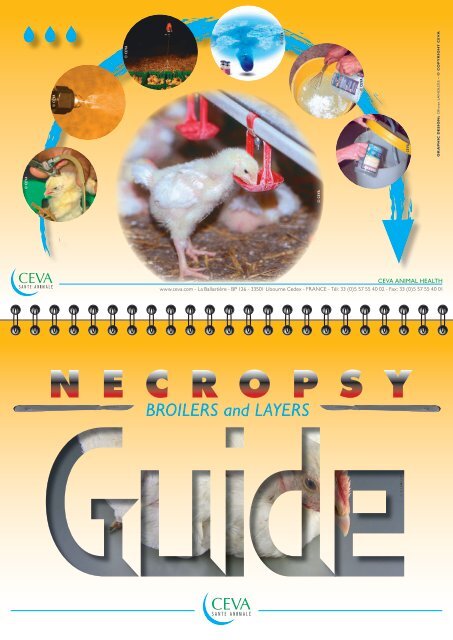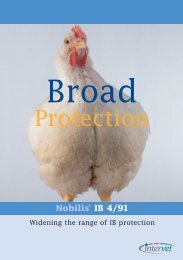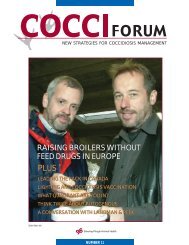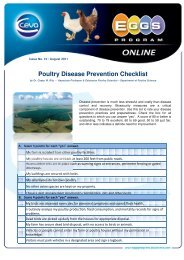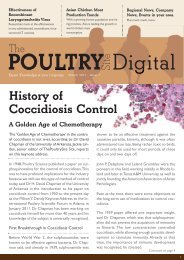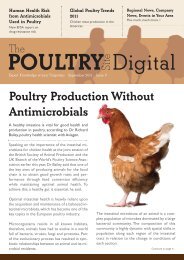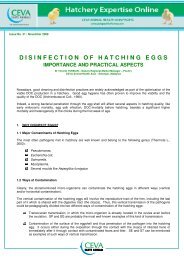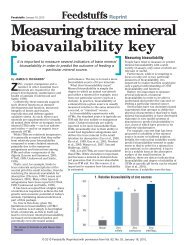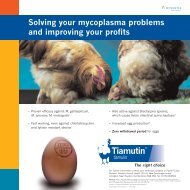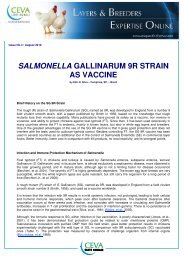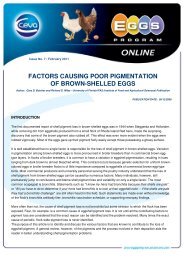BROILERS and LAYERS NECROPSY - The Poultry Site
BROILERS and LAYERS NECROPSY - The Poultry Site
BROILERS and LAYERS NECROPSY - The Poultry Site
You also want an ePaper? Increase the reach of your titles
YUMPU automatically turns print PDFs into web optimized ePapers that Google loves.
2Performing consistent <strong>and</strong> systematic field necropsies provide youwith valuable information for good flock management.For further on-farm training of necropsy techniques contact your local CEVA representatives.A Good Necropsy is One Performed SystematicallyNecropsy TechniquesEQUIPMENT© O.LANGLOISForceps - Scalpel - Scissors - Gloves - Heavy shears© O.LANGLOISBefore the Necropsy• Review the clinical history.• List the differential diagnosis.• Observe clinical signs of flock.• Euthanize the bird bycervical dislocation method.• Examine the bird’s exterior.Start at the Head• Moisten feathers with water.• Lay bird on its back.• Cut through corner of mouthto open it flat- examine oral cavity.• Continue incision throughthe skin <strong>and</strong> esophagusfollowing esophagus to the crop- examine vagus nerve,thymus, esophagus,<strong>and</strong> crop contents.• Cut through larynx <strong>and</strong> continueto open trachea- examine trachealmucous membranes<strong>and</strong> luminal contents.• Remove upper beak tip with a transverse cut- inspect the nasal cavity <strong>and</strong> infraorbital sinuses.• Cut open sinuses if swollen- examine fluids,- examine eyes.© O.LANGLOIS © O.LANGLOIS3
4© O.LANGLOIS © O.LANGLOISOpening the Body• Cut the skin between the leg <strong>and</strong> abdomen.• Pull <strong>and</strong> twist legs to disarticulate the femur from the hip.• Cut the skin across the abdomen <strong>and</strong> reflect the skin to exposeabdomen <strong>and</strong> pectoral muscles.© O.LANGLOISExposing the Viscera• Cut across abdominal muscles following the sternal border.• Continue through ribs to throracic inlet.• Cut <strong>and</strong> open the rib cage to expose the viscera- examine surface of exposed organs <strong>and</strong> take microbiological samplesif needed before proceeding to next step.© O.LANGLOISExamining the Viscera• Stop <strong>and</strong> culture diseased organs if desired before proceeding tonext organ to avoid contamination.• Reflect liver <strong>and</strong> intestines to visualize air sacs, lungs, <strong>and</strong> kidneys.• Remove organs as needed for further sampling<strong>and</strong>/or better visualization.Organs to examine:• liver, spleen, pancreas.• kidneys.• ovaries.• heart, lungs.• intestinal tract (including cecal tonsils).• sciatic nerves <strong>and</strong> plexus.• brain.• bones <strong>and</strong> marrowbone.© O.LANGLOIS5
6GLOSSARY :N E C R O P S YGuide<strong>BROILERS</strong> <strong>and</strong> L AYERSAGID: .... Agar Gel Immuno DiffusionAGP:....... Agar Gel PrecipitationCF: .......... Complement FixationELISA:... Enzyme Linked ImmunoSorbent AssayHA:......... HaemAgglutinationHI:........... Haemagglutination InhibitionIF:............ ImmunoFluorescencePA:.......... Plate AgglutinationRPA:....... Rapid Plate AgglutinationRSA:....... Rapid Serum AgglutinationSN:.......... SeroNeutralizationVN:......... Virus Neutralization© O.LANGLOISPerforming consistent <strong>and</strong> systematic field necropsies provide youwith valuable information for good flock management.This necropsy guide is a practical tool which, after describing the autopsy, providesa tabulated list of Broilers <strong>and</strong> Layers hens diseases classified by tropism.Six tropismshave been defined:RespiratoryNervous systemLocomotor systemDigestive tractLiverMiscellaneousFor each of those six tropisms <strong>and</strong> for each disease, etiology, clinical signs <strong>and</strong> photosof the most characteristic lesions that hint at that disease are provided, as well as the sampling <strong>and</strong>analysis to be carried out to confirm its diagnosis.<strong>The</strong>se panels have been specially designed for easy references during your autopsies for moreaccurate lesion diagnosis <strong>and</strong> to adopt the best prevention <strong>and</strong> treatment strategies.p10p20p22p24p26p32Dr. N. DUPUY7
8Age (Weeks)DiseasesAdenovirosis p15Aflatoxicosis p30Ammoniac intoxication p10Arthritis p22Aspergillosis p19Avian Encephalomyelitis p20Avian Vibrionic Hepatitis p28Avian Influenza p12Avian Poxvirosis p15Botulism p20Chicken Anemia p33Clostridiosis p24Coccidiosis p25Colibacillosis p29Colibacillosis p18Cryptosporidiosis p18Egg Drop Syndrome p34Hepatitis p27Histomoniasis p31List of the diseases according to their tropism <strong>and</strong> the age of appearance1 2 3 4 5 6 7 8 9 10 11 12 13 14 15 16 17 18 19 20 21 22 23 24 25 26 27 28 29 30Infectious Bronchitis p13Infectious Bursal Disease p32Infectious Coryza p16Infectious Laryngotracheitis p14Infectious Nephritis p32Infectious Synovitis p23Leucosis p27Liver steatosis p31Marek Disease p21 & p26Mycoplasmosis p16Necrotic Dermatitis p34Newcastle Disease p11 & p21Pasteurellosis p17 & p21Salmonellosis p21 & p29Syngamosis p18Trichomonosis p25Tuberculosis p28Viral Arthritis p23Vitamin A deficit p10Vitamin E <strong>and</strong>selenium deficit p21 & p221 2 3 4 5 6 7 8 9 10 11 12 13 14 15 16 17 18 19 20 21 22 23 24 25 26 27 28 29 309
10Vitamin A DeficitAmmoniacIntoxicationNewcastle DiseaseETIOLOGY-Hosts CLINICAL SIGNS AND LESIONS DIAGNOSISBroilersLayersParamyxovirustype IBroilersLayersMembranous deposit on theupper respiratory mucosa.Little signs during the earlyevolution.Mortality at the end ofevolution.Other signs: keratomalacia(degeneration of cornea),xerophtalmia (dry eye),nephritis, urates deposits onvarious organs.Non specific <strong>and</strong> discreetrespiratory signs.Conjunctivitis.Morbidity = 100%.RESPIRATORY:• from simple oculo-nasaldischarge to severebreathing disorders.NERVOUS:• torticolis.DIGESTIVE:• hemorrhagic lesions(proventriculus, smallintestine, cecal tonsils).Morbidity = 100%.Mortality = 5-100%.© LDA 22 © LDA 22© N. DUPUYSAMPLES:• dosing vitamin A in blood,liver <strong>and</strong> eggs.HISTOLOGY:• trachea, larynx, esophagus➡ epithelial metaplasia.<strong>The</strong>rapeutic diagnosis:administration ofvitamin A.Ammoniac smell.Ammoniac dosage(should be less 25 cm 3 /m 3 ).SAMPLES:• swabs: trachea, lung,cloacae, proventriculus,brain➡ virus isolation <strong>and</strong>immunofluorescence.HISTOLOGY:• brain➡ encephalitis.• lung➡ intestinal pneumonia.SEROLOGY:➡ ELISA, SN, HI ++.11
12Avian InfluenzaETIOLOGY-Hosts CLINICAL SIGNS AND LESIONS DIAGNOSISOrthomyxovirusBroilersLayersRespiratory disorders withvarious intensity.RESPIRATORY:• sinusitis, nasal discharge,hemorrhage.DIGESTIVE:• diarrhea.NERVOUS:• non specific.Layers:• drop of production.Morbidity = 50-80%(sometimes 100%).Mortality = 1-100%.© CEVASAMPLES:• swabs: trachea<strong>and</strong> cloacae➡ virus isolation <strong>and</strong>identification (HA).SEROLOGY:➡ HI, ELISA, AGP.Differential with NDV.Infectious BronchitisCoronavirusBroilersLayersSevere respiratory disorders.Seldom: nephritis.Layers:• drop of production.• bad eggs quality.• rough <strong>and</strong> circled shell.Morbidity = 80%(sometimes 100%).Mortality variable.© N. DUPUY© N. DUPUYSAMPLES:• swabs: trachea <strong>and</strong> lung➡ virus isolation<strong>and</strong> IF direct.HISTOLOGY:• trachea➡ epithelial cellshyperplasia.SEROLOGY:➡ HA, ELISA, AGID,SN, IF.13
14Infectious LaryngotracheitisAvian PoxvirosisETIOLOGY-Hosts CLINICAL SIGNS AND LESIONS DIAGNOSISHerpesvirusBroilersLayersPoxvirusBroilersLayersRESPIRATORY:• Acute: breathing disorders,hemorrhagic nasal discharge(++).• Sub-acute: tracheitis,hemorrhagic,fibrinous exudates.Layers:• drop of production,then return to normal curve.Morbidity variable.Mortality = 5-70%.RESPIRATORY:• Cutaneous form:cutaneous lesions (nodularlesions) around head (partwith no feathers).• Strictly larynx = diphteriticform:diphteritic membranes inoral cavity (nodular lesions).Morbidity variable.© LDA 22 © N. DUPUYSAMPLES:• swabs: trachea, lung, sinus➡ virus isolation.HISTOLOGY:• trachea➡ IF intranuclearinclusion bodies.SEROLOGY:➡ ELISA, IF, SN.SAMPLES:• cutaneous lesions➡ virus isolation.HISTOLOGY:• skin➡ intra-cytoplasmicinclusion.SEROLOGY:➡ IF, SN, HA, AGP.(mostly clinical diagnosis).AdenovirosisAdenovirorisBroilersDiscreet respiratorydisorders.Morbidity variable.SAMPLES:• trachea, lung, feces➡ virus isolation.HISTOLOGY:• trachea➡ intranuclear inclusions.SEROLOGY:➡ AGP, IF, SN.15
16Pasteurellosis (Fowl Cholera)Infectious Coryza MycoplasmosisETIOLOGY-Hosts CLINICAL SIGNS AND LESIONS DIAGNOSISMycoplasmagallisepticumMycoplasmasynoviaeBroilersLayersAvibacteriumparagallinarum(formerly known asHaemophilusparagallinarum)BroilersLayersPasteurellamultocidaBroilersLayersRESPIRATORY:Chronic Respiratory Disease:• sinusitis (infra orbital).• late growth.• salpingitis.• airsacculitis.Layers:• drop of production.Morbidity: until 80%.RESPIRATORY:• abundant nasal discharge.• conjunctivitis, sinusitis,facial edema (swollen sinus).High morbidity.Low mortality (unlesscomplicated with MG).RESPIRATORY:Highly acute:• early (acute) mortality.Acute:• cyanosis (blue mucosa).• nasal discharge.• diarrhea with associatedfecal material:- initially watery <strong>and</strong>whitish coloration- lately greenish,containing mucus.Chronic:• breathing disorders.• conjunctivitis, tracheitis,airsacculitis, pneumonia.LESIONS:Acute:• vascular lesions(heart petechia…).• swollen liver <strong>and</strong> necrosis.• enteritis.• lesions of genital tractChronic:• localized infectionscan be everywhere.© LDA 22 © LDA 22© N. DUPUYSAMPLES:• air sac <strong>and</strong> trachea➡ isolation<strong>and</strong> identification.HISTOLOGY:• trachea <strong>and</strong> air sacs➡ high infiltration.SEROLOGY:➡ RSA, HI, ELISA.SAMPLES:• swabs of trachea <strong>and</strong> sinus➡ isolation(direct Gram+)<strong>and</strong> identification.SEROLOGY:➡ HI, RSA.SAMPLES:• bone marrow, blood, liver,swab of nasal cavity<strong>and</strong> air sacs.HISTOLOGY:• hepatic lesions: similar tosalmonellosis.SEROLOGY:➡ RPA, PA, ELISA.17
20AvianEncephalomyelitisBotulismVitamin E <strong>and</strong>Selenium DeficitETIOLOGY-Hosts CLINICAL SIGNS AND LESIONS DIAGNOSISPicornavirusBroilersLayersClostridiumbotulinumBroilersLayersChicks:• head shaking, increasedwhen hang birds by foot.Morbidity until 60%.Mortality = 25-50%.Layers:• drop of production(with no associated signs).Progressive flaccid paresis.Evolution from legs to neckparalysis.No macroscopic lesions.Ataxia, brain edemahemorrhage.Muscular dystrophy.© LDA 22 © LDA 22© N. DUPUYSAMPLES:• brain sampling➡ virus isolation.HISTOLOGY:• brain, pancreas heart,liver➡ microscopic lesions.SEROLOGY:➡ ELISA, SN.SAMPLES:• intestinal orstomach content.TESTING:• botulotoxin testingon mice.SAMPLES:• brainHISTOLOGY:• brain➡ necrosis, edema.OTHER:• feed: vitamin E dosage.OTHERS:Newcastle DiseaseMarek DiseasePasteurellosisSalmonellosisNON SPECIFIC NERVOUSSYMPTOMS.21
22Vitamin E <strong>and</strong>Selenium DeficitArthritisInfectious SynovitisETIOLOGY-Hosts CLINICAL SIGNS AND LESIONS DIAGNOSISStaphylococcusaureusBroilersLayersMycoplasmasynoviaeBroilersLayersMyositis: light-colored streaksin the breast.Encephalomalacia.Seldom chronic arthritis.Arthritis with edema.Lesions of the synovialmembranes.© N. DUPUY © N. DUPUY© LDA 22SAMPLES:• digestive content.HISTOLOGY:• muscles.SAMPLES:• joint content➡ bacteriology.SAMPLES:• infected joint➡ isolation ofMycoplasma.SEROLOGY:➡ RPA, PA, HI, ELISA.Viral ArthritisReovirusBroilersLayersEdema of the tendonsheaths.Rupture of thegastrocnemiustendon.© N. DUPUYSAMPLES:• infected joint➡ virus isolation, IF.SEROLOGY:➡ ELISA, SN, AGID.23
24Trichomonosis CoccidiosisClostridiosisETIOLOGY-Hosts CLINICAL SIGNS AND LESIONS DIAGNOSISClostridiumperfringensClostridiumcolinumBroilersLayersEimeria spp.BroilersLayersTrichomonasgallinaeBroilersLayersNecrotic enteritis:• anorexia.• hemorrhagic enteritis.• distention of the intestine(gas).• hepatic necrosis.Ulcerative enteritis:• very severe in quails.• ulcerative lesions of thelower digestive tract.DIGESTIVE:• enteritis of various severity.• various lesions distributions.DIGESTIVE:• feed apprehension disorders.• yellow nodules inoral cavity, esophagus,crop, intestine (seldom).Technical documenton parasitologyAuthor: J.M. Répérant© LDA 22 © N. DUPUYSAMPLES:• intestine <strong>and</strong> liver➡ isolation <strong>and</strong>identification.HISTOLOGY:➡ ulcerative lesion ofintestine.SAMPLES:• intestine <strong>and</strong> cecum➡ parasitesexamination.SAMPLES:the targeted organs.•25
26Marek DiseaseLeucosisETIOLOGY-Hosts CLINICAL SIGNS AND LESIONS DIAGNOSISHerpesvirusBroilersLayersOncornavirusLayersParalysis.Nerves hypertrophy.Tumors: liver, skin, heart,muscles, eyes...Diffuse <strong>and</strong> nodularneoplasms:liver, spleen, kidney.Poor morbidity.© N. DUPUY © N. DUPUY© N. DUPUYSAMPLES:• tumors <strong>and</strong> nerves.• feather tracts➡ virus isolation.HISTOLOGY:➡ neoplasic infiltrations.SEROLOGY:➡ AGID, SN, IF, ELISA.SAMPLES:• liver, spleen, kidney,bursa of Fabricius.HISTOLOGY:➡ tumoral infiltrationby lymphoblasts.➡ tumoral infiltration“intrafollicular” withinbursa.SEROLOGY:➡ ELISA, CF.Hepatitis (inclusion)Adenovirus IHemorrhage syndrome.Medullar hypoplasia.Hepatitis.Nephritis.SAMPLES:• liver <strong>and</strong> marrowbone➡ virus isolation.HISTOLOGY:➡ degeneration<strong>and</strong> necrosis ofhepatocytes(inclusion bodies).27
28Avian VibrionicHepatitisETIOLOGY-Hosts CLINICAL SIGNS AND LESIONS DIAGNOSISCampylobacterspp.BroilersChronic infection:• drop of egg production.• anemia.• emaciation.• spleen hypertrophy.• hepatitis lesions.SAMPLES:• bile, liver, spleen, heart➡ bacteriology.TuberculosisColibacillosisMycobacteriumaviumBroilersLayersEscherichiacoliBroilersLayersChronic infection:• lameness.• emaciation.• diarrhea.• drop of egg production.Specific lesions:• granuloma.• liver, spleen, intestine.Coligranulomatosis:• granulomatosis lesions oncecum, intestine, liver.• perihepatitis.• pericarditis.CRD complications.© N. DUPUY © LDA 22SAMPLES:• liver, spleen.HISTOLOGY:• Ziehl Nielsen coloration➡ AAR.• inflammatory granuloma.SAMPLES:• liver➡ bacteriology.HISTOLOGY:➡ inflammatorygranuloma.➡ perihepatitis.SalmonellosisSalmonellaspp.BroilersLayersYellowish <strong>and</strong> stinkingdiarrhea.• spleen:hypertrophy.• liver:hypertrophygreen (bronzed)small necrosis area: 1-3 mm.Horizontal transmission.© LDA 22SAMPLES:• liver, spleen, eggs, cloacaeswabs, litter➡ bacteriology.HISTOLOGY:• liver➡ hepatitis.• heart➡ myocardial necrosis.Vertical transmission.SEROLOGY:➡ RPA, PA, ELISA.29
30HistomoniasisETIOLOGY-Hosts CLINICAL SIGNS AND LESIONS DIAGNOSISHistomonasmeleagridisBroilersLayersEnterohepatitis:• liver: round necrosis lesionswith hemorrhagic center.• cecum: cecal wallsulceration.© N. DUPUYSAMPLES:• liver <strong>and</strong> cecum➡ microscopicexamination.HISTOLOGY:• liver.Liver Steatosis ofthe Laying HensNutritionaldiseaseObesity.Significant decreaseof egg production.Liver hypertrophy.Steatosis.Hemorrhage.© LDA 22SAMPLES:• liver.HISTOLOGY:➡ steatosis(specific coloration:Soudan black).AflatoxicosisAflatoxinsBroilersLayersCatarrhal enteritis.Liver: degeneration of cellsevolving to cirrhosis.Bruises on subcutis <strong>and</strong>muscles.© Dr. KRIENGSAKSAMPLES:• feed:➡ toxin dosage +reproduction ofdisease.31
32Infectious BursalDisease (IBD)Infectious NephritisChicken AnemiaETIOLOGY-Hosts CLINICAL SIGNS AND LESIONS DIAGNOSISBirnavirusBroilersPulletsPicornavirusBroilersCircovirusBroilersLayersInflammation, followed by anatrophy of the bursa.Petechia in duodenum.Non specific symptoms.Thymus <strong>and</strong> bone marrowatrophy.Liver atrophy.Hemorrhage: proventriculus,liver <strong>and</strong> muscles.Generalized anemia.Morbidity variable.Mortality variable(secondary infections).© N. DUPUY © N. DUPUY© N. DUPUYSAMPLES:• bursa <strong>and</strong> spleen➡ IF direct <strong>and</strong>serotype.HISTOLOGY:• bursa➡ lymphoidfollicles necrosis,hemorrhage.SEROLOGY:➡ ELISA, SN, IF, AGID.SAMPLES:• kidney, cloacae➡ virus isolation, IF direct.HISTOLOGY:➡ degeneration.SEROLOGY:➡ VN, IF.SAMPLES:• liver, marrowbone.HISTOLOGY:➡ generalized lymphoiddepletion.SEROLOGY:➡ ELISA.33
34EDSETIOLOGY-Hosts CLINICAL SIGNS AND LESIONS DIAGNOSISAdenovirusLayersDrop of production until50% during 6 to 12w.Discolored shell:• egg without shell.• normal albumen.SAMPLES:• liver <strong>and</strong> oviduct➡ virus isolation, IF.HISTOLOGY:➡ edema, atrophy ofgl<strong>and</strong>ular tissue.SEROLOGY:➡ ELISA, SN, AGID.Necrotic DermatitisClostridiumStaphylococcusEscherichiacoliNecrosis of sub cutaneouslayer.© N. DUPUYSAMPLES:• cutaneous lesions➡ direct isolation(Gram).COPYRIGHT - February 2007“All product names, trademarks, logos, designs, texts, graphics, images on this Technical document are the property of CEVA SANTE ANIMALE or its licensors.In accordance with the provisions of Intellectual Property Law, any reproduction, display or performance, use, adaptation, modification, incorporation or translationin part or entirely of those elements <strong>and</strong> more generally of any information contained in this Technical document is strictly prohibitedexcept with the prior written authorisation of CEVA SANTE ANIMALE.”35


